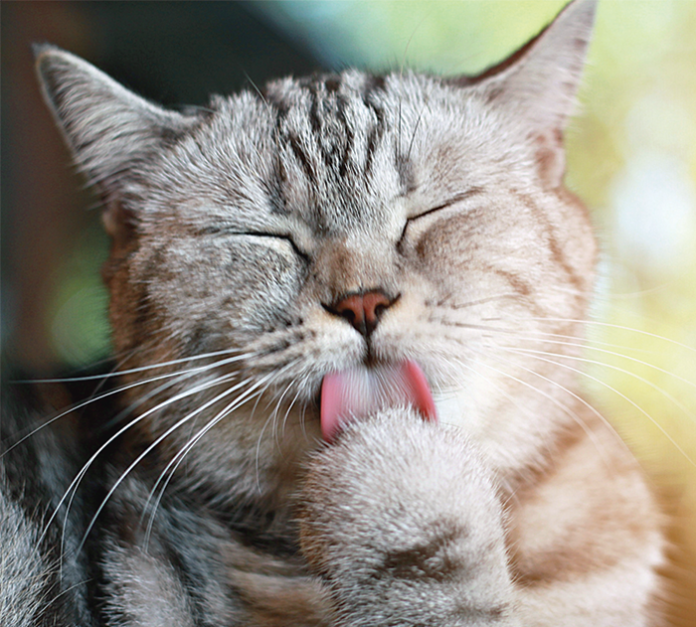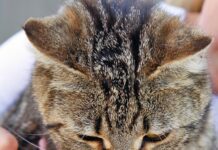Your cat is kneading in your lap and you notice some dry flakes. Then she rolls over and you realize how little hair there is on her belly. When your cat is shedding more flakes of skin than normal and/or is losing hair, it’s time to look for a cause. This could be related to excess oil production by the sebaceous glands in the skin, which leads to an “oily” dandruff or seborrhea.
“When we talk about dandruff, we have to consider whether it’s itchy or not,” says William H. Miller Jr. VMD DACVD Professor Emeritus of Medicine, Section of Dermatology at Cornell’s College of Veterinary Medicine. “If it’s itchy, did the itching start first, followed by the flakes? And to make life more interesting, is the flaking localized to a spot or two, a region of the body like the rump, or generalized? If the dandruff is generalized and not itchy, then low environmental humidity or dietary issues are at the top of the list. If it is itchy and generalized, then allergy, especially food allergy, rises to the top of the list. If it is itchy and regionalized, external parasitic diseases such as fleas and cheyletiella (a type of mite) must be considered first. If it is localized, with or without itching, infectious causes such as ringworm and staph infection get considered first. All of the various forms of dandruff and dry skin, with or without itching, can also have oddball causes like autoimmune skin diseases.”
Find Out Why
Good detective work, history, and diagnostics will be required to determine the cause of your cat’s problem.
Dry Air. Just like people tend to get dry skin and suffer from dandruff when humidity is low, the same can happen to your cat. During winter months, especially if you have “dry” heat, such as a wood stove or forced hot air, your cat’s skin will suffer from a loss of humidity. Dr. Miller offers these suggestions, “If we’re talking low humidity, humidify the house if possible and don’t bathe the cat. When the humidity is low, a wet body (you or your cat) acts as a humidifier and the moisture from you is drawn into the environment. Gentle combing to remove the flakes is the standby, but moisturizer sprays also are good if your cat will put up with them.” Only use products labeled as safe for use in cats.
You can help from inside out by encouraging your cat to drink more. Feeding canned food will add some liquid to her diet. If your cat doesn’t seem to be a big water drinker, try a pet water fountain to see if your cat will drink more from “moving water.” Experiment to see if she prefers cold or room-temperature water. Make sure the water bowls are always clean, and that the water is fresh by completely replacing it every day.
Fleas. Even if your cat is an indoors-only cat, fleas are possible. Pets are willing to share fleas, and fleas are equal opportunity parasites.
To diagnose fleas, look carefully at the hair around your cat’s tail head. You might notice tiny brown bugs running or jumping. If you roll your cat over, you might spot these parasites running across the groin area.
If you don’t see any parasites but are still suspicious, have your cat stand on a white sheet of paper or white cloth. Scratch her hair; especially around the tail area. Then check the paper or cloth for what at first looks like salt and pepper. If you add a drop of water, you will now see red streaks. That debris you scratched off consists of flea poop (composed largely of host blood) and flea eggs.
Be sure to check all your pets. Even if a pet seems flea-free, you will need to treat all the animals and the environment, including your house. Flea infestations are often characterized by more than just dry skin. Many cats will have some degree of reaction, with inflamed skin and excoriations from biting or scratching.
Mites. Cheyletiella is a mite dubbed “walking dandruff.” These mites live on the surface of your cat’s skin and feed on skin flakes. Cats can have two types of these mites: Cheyletiella blakei and, especially in tropical areas like Hawaii and Florida, a fur mite called Lynxacarus radovskyi.
Cats with Cheyletiella may develop reddish yellow crusts. Lynxacarus mites tend to hang onto hair shafts, usually in the tail area. The cat’s haircoat may look rusty in color, and other clinical signs may be apparent, including gastrointestinal upset, gingivitis, and a loss of appetite.
Mite infestations are usually diagnosed by your veterinarian, who may be able to identify the mites. Treatment usually consists of medicated shampoos followed by topicals that will kill mites with drugs such as moxidectin, fipronil, or selamectin.
Diet Issues
Food allergy dermatitis can appear as intense itching, often around your cat’s head and neck. Ears may be inflamed as well. The dermatitis can advance to generalized itching with related flaking skin or even sores.
Diagnosing a food allergy requires time and a dedicated owner. Food allergies are due to improper reactions by your cat’s immune system to food proteins. You will need to feed a diet with novel (new to your cat) proteins for six to 12 weeks to get her skin to “cool down.”
Your veterinarian may prescribe steroids for a short period of time to help your cat get comfortable quickly. Once things are back to normal, add one previously fed protein at a time and watch for any reaction by your cat. You may see itching start up in a day or it might take two weeks. This “challenge” then lets you know what proteins to avoid in the future.
Sometimes confused with food allergies, nutritionally deficient diets can lead to flaking, dry skin and a brittle hair coat. Vitamin E and fatty acid supplements may help a cat with minor skin problems, but your cat’s diet needs the right balance between omega 3 and omega 6 fatty acids. Too much or too little of these nutrients can lead to skin and other health problems. Before reaching for a supplement, discuss this with your veterinarian.
Most commercial diets are balanced for these nutrients, but some cats will benefit from special “skin care” diets, including prescription ones. Prescription diets may include extra supplements, novel proteins in case food allergy is involved, or hydrolyzed proteins that allow for easy and non-reactive digestion.
When making a diet change to improve skin health, expect to wait a month or possibly more to see any dramatic improvements. It takes time for skin to heal and new hair to grow in. Dr. Miller points out, “If your cat is itchy, a response to the supplement should be seen within 14 days. For non-itchy flakes, the trial needs to be continued for a full 30 days.”
If you choose to feed a home cooked diet for your cat, you need professional assistance to get the diet properly balanced. A referral to a veterinary nutritionist can provide a recipe that will keep your cat in tiptop condition.
Careful Considerations
Autoimmune causes are possible, but they’re much less common. In order to diagnose these problems, your veterinarian will require a biopsy and special testing to identify the disease.
Obesity can result in dandruff (dry or oily), as obese cats can’t groom well, so hair tends to mat and block skin glands. Obviously, a weight loss and exercise program can help, but you may need to shave matted areas and possibly bathe your cat to help restore healthy skin.
Luckily, most causes of dandruff and dry skin in cats are reasonably easy to diagnose and treat. If you try one or two simple treatments at home with no results, however, schedule a veterinary visit to get to the bottom of your cat’s problem and give you a solution.
Normal Dander
Dandruff is excessive and obvious shed flakes of skin, as opposed to dander, which is normal and barely visible. Dander is the term used for your cat’s normal shedding of skin cells, and it’s virtually unnoticeable unless you have allergies to cats. The dander, along with dried saliva from grooming, is what stimulates allergic reactions in some people. Normal dander is not associated with itching or obvious flakes.




